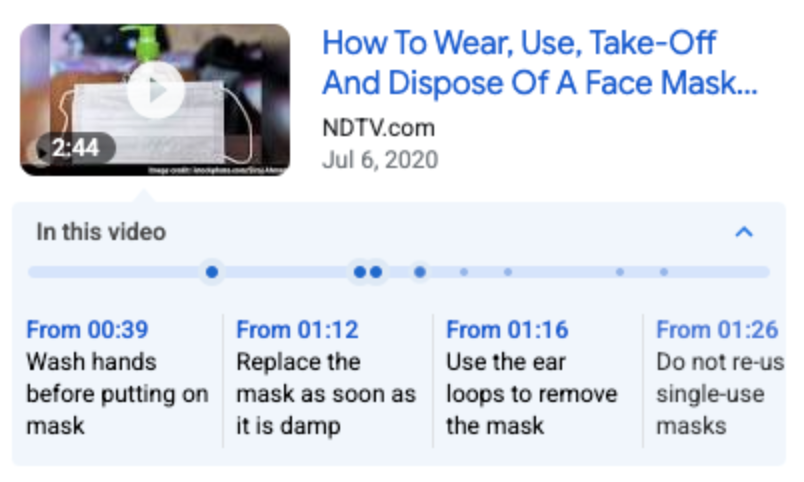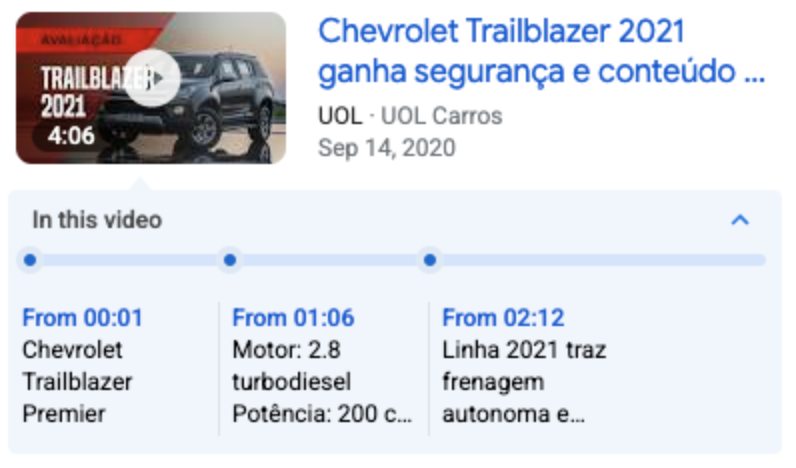2021년 7월 19일 월요일
Google에서는 2019년에 동영상의 중요한 부분을 처음 출시한 이후로 기능을 계속 확장하고 개선하고 있습니다. 디자인을 개선했으며, Google 검색을 사용할 수 있는 모든 지역에서 휴대기기와 데스크톱에 표시되는 더 많은 동영상에 중요한 부분 기능을 지원했습니다. 중요한 부분은 더 많은 사용자가 동영상에서 가장 관련성이 높은 세그먼트로 바로 연결하고 책의 장처럼 세그먼트를 탐색하는 데 도움이 됩니다.
오늘 Google에서는 각 세그먼트에 직접 라벨을 지정할 필요 없이 사이트의 동영상에 중요한 부분을 사용 설정하는 새로운 방법을 발표합니다. 동영상 내 특정 타임스탬프로 건너뛰는 URL 패턴을 Google에 알리기만 하면 됩니다. 그러면 Google에서 AI를 사용하여 동영상의 중요한 부분을 식별하고 이 부분으로 바로 연결되는 링크를 Google 검색결과에 표시합니다.


SeekToAction 베타 테스트는 Google I/O에서 처음 발표되었습니다. 오늘부터 베타 버전이 종료되며 동영상이 포함된 모든 사이트에서 SeekToAction 마크업을 사용할 수 있습니다. 다음은 SeekToAction 마크업을 구현할 때 유의해야 할 몇 가지 도움말입니다.
- 동영상의 시작점이 아닌 다른 지점에 딥 링크를 설정할 수 있는 URL이어야 합니다. 예를 들어
https://www.example.com/example?t=30을 사용하면 동영상의 30초 지점에서 시작됩니다. - Google이 중요한 부분을 자동으로 식별하기를 원하는 모든 동영상 페이지에
SeekToAction마크업을 사용하고 추가 가이드라인을 따릅니다. 자세한 예시를 확인하세요. - Google이 동영상의 중요한 부분을 자동으로 식별하려면 동영상 콘텐츠 파일을 가져올 수 있어야 합니다.
SeekToAction 마크업은 개발자가 소유한 사이트에 삽입된 동영상에만 적용됩니다. 본인이 schema.org 마크업을 관리하지 않는 타사 플랫폼에 동영상을 게시하는 경우 타사 플랫폼에 문의하여 SeekToAction 마크업이 지원되는지 확인하세요.
SeekToAction 마크업이 중요한 부분을 사용 설정하고 사용자가 동영상에 더욱 몰입하도록 지원하는 더 쉽고 효율적인 방법이 되길 바랍니다. 궁금한 점이 있다면 포럼에 게시하거나 Twitter에서 @googlesearchc를 통해 문의하거나 문서 페이지에서 바로 의견을 제출해 주세요.
